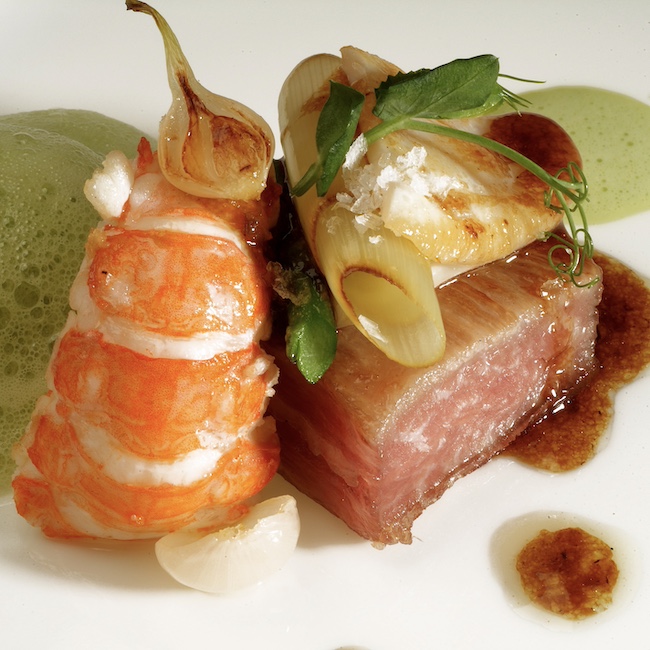.png.transform/rendition-xs/image_image%20(1).png)
The Fresh Meats of Ibérico Pigs and the Taste of Spanish Tradition
Secreto, Presa, Pluma, Carrillera, Lagarto… Learn all about these prime cuts and how to make the most out of them
In the sun-drenched pastures of the Iberian Peninsula, where ancient oak trees dot the landscape and acorns fall like gifts to the earth, the Ibérico pig lives a life that is deeply entwined with the land. Beyond its famous jamón ibérico and other well-known embutidos (cold meats), the fresh cuts of the Ibérico pig—secreto, presa, pluma, carrillera, lagarto—offer an unparalleled expression of flavor, texture, and a connection to the land. Each cut has its own story to tell, a journey from field to plate that honors the animal and the traditions that nurture it.

Secreto: The hidden cut
Starting with one of the most mysterious cuts, secreto—which means “secret” in English—has long been a butcher’s treasure. This flat, marbled cut is hidden beneath the fat, near the shoulder, and has a remarkable ability to surprise those who taste it for the first time. It is prized for its balance of lean muscle and fat, which gives it a luscious texture when cooked. Grilled simply with salt, secreto quickly forms a crispy exterior while remaining tender and juicy inside. The flavor is buttery, rich, and slightly sweet, revealing the pig’s acorn-rich diet. It is a revelation, one that keeps people coming back for more, eager to unlock its secrets.

Presa, a crown jewel
Presa, taken from the shoulder, is a hefty, well-marbled piece of meat, presa has the heartiness of a steak and the tenderness that Ibérico pork is famous for. It’s a cut that can be grilled, roasted, or even cooked rare—something nearly unheard of in the world of pork. The intense marbling throughout the presa results in a depth of flavor that is almost gamey, with a buttery richness that melts in the mouth. Its deep red color and beef-like qualities make it a favorite for chefs looking to highlight the unique qualities of Ibérico pork. A simple preparation, such as grilling with a touch of sea salt, allows the natural flavors to shine.

Pluma, the feathered cut
Another gem of the Ibérico pig, pluma—which means "feather" in Spanish—is a cut that hails from the neck, where the meat is shaped like the tip of a feather. Unlike the denser presa or the hidden secreto, pluma has a delicate texture, soft and tender, with a fine marbling of fat. This makes it one of the most succulent cuts available.
The flavor of pluma has a subtle sweetness and richness that comes from the pig’s natural diet of acorns. Its tenderness, combined with a perfect balance of fat, makes it a versatile cut, ideal for grilling, searing, or even slow-cooking, although it is often cooked quickly over high heat to retain its juiciness. When served simply, it can be a revelation of how pork, in the right hands, can become a sophisticated delicacy.

Carrillera, cheeks of comfort
Carrillera, or pork cheeks, offers something entirely different—a deep, soulful cut that speaks to the heart of rustic Spanish cooking. This cut comes from the cheek muscles of the Ibérico pig, and because these muscles work constantly as the pigs graze, carrillera is full of collagen, which breaks down during slow cooking to create a silky, gelatinous texture. It is perfect for braising, a technique that turns the tough, sinewy meat into something meltingly tender and full of flavor.
The flavor of carrillera is rich and meaty, with a comforting depth that pairs beautifully with earthy sauces, red wine reductions, or root vegetables. Its texture is its defining feature—once braised, it becomes fall-apart tender, with a soft, almost creamy mouthfeel. Carrillera is a cut that invites slow eating, each bite rich with the essence of the animal.

Lagarto, the lizard shape-like delight
While lagarto may not be as well-known outside of Spain, it holds its own among the fresh cuts of Ibérico pigs. The name lagarto, which means "lizard" in Spanish, refers to the cut’s slender, reptile-like shape. Found running alongside the ribs, lagarto is a thin, elongated strip of meat that, despite its modest appearance, delivers intense flavor.
Lagarto is best cooked quickly over high heat—grilled, seared, or even stir-fried. The meat is tender and slightly chewy, with a satisfying bite, and the proximity to the bones imbues it with a deep, savory richness. The fat, while less abundant than in cuts like presa, renders beautifully, creating a subtle layer of flavor that elevates even the simplest preparation. Lagarto is a perfect cut for tapas, sliced thin and served with a sprinkle of sea salt, where its flavor can be enjoyed in small, intense bites.
The magic of marbling
At the heart of what makes Ibérico pork so exceptional is its fat—an indulgence that is not to be avoided but embraced. The fat of Ibérico pigs, especially those raised on an acorn diet, is high in oleic acid, the same healthy fat found in olive oil. This gives the meat a buttery, silky quality and infuses it with a sweetness that balances the savory, meaty notes.
The marbling in cuts like secreto, presa, and pluma is what makes these pieces of meat so special. It allows for the slow rendering of fat during cooking, which bastes the meat from the inside out, ensuring it stays moist and tender. This fat is also the key to the unique flavor profile of Ibérico pork—a nuttiness that comes directly from the acorns and a depth of flavor that speaks of the land itself. Each bite of Ibérico pork is not just a taste of the animal, but of the dehesa landscape where the pigs roam freely.

